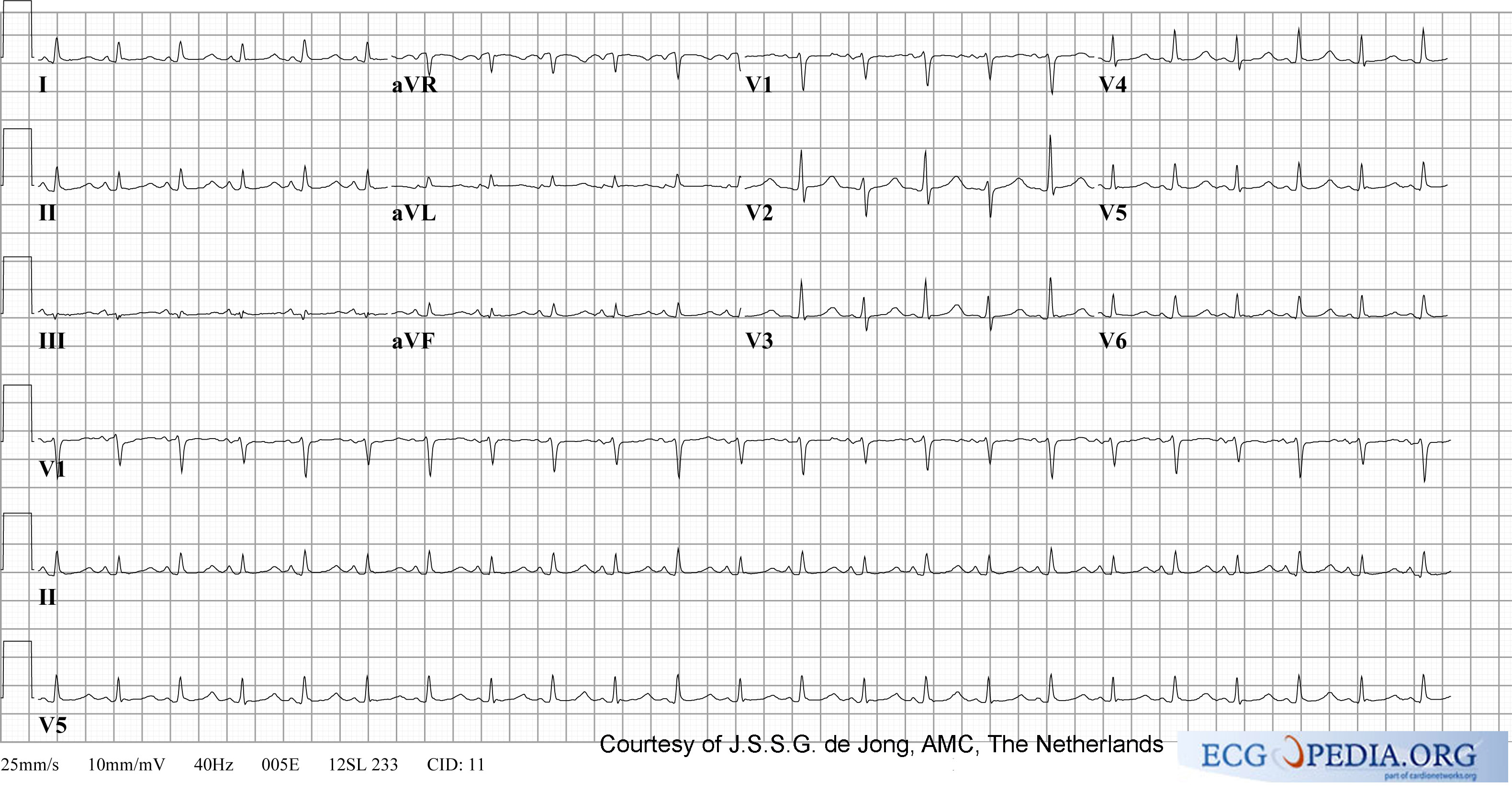HIV induced pericarditis electrocardiogram: Difference between revisions
No edit summary |
No edit summary |
||
| Line 6: | Line 6: | ||
{{CMG}} {{AE}} {{RG}} | {{CMG}} {{AE}} {{RG}} | ||
==Electrocardiogram== | ==Electrocardiogram== | ||
*Acute | *Acute [[pericarditis]] can mimic myocardial infarction (STEMI) signs and electrocardiogram and present with chest pain and cardiac enzyme (bio-marker) elevation.<ref name="Castellanos1997">{{cite journal|last1=Castellanos|first1=Agustin|title=Electrocardiography in Clinical Practice: Adult and Pediatric, Fourth Edition. By T. Chou. W.B. Saunders, Philadelphia (1996) 729 pages, illustrated, $99.00 ISBN: 0721656471|journal=Clinical Cardiology|volume=20|issue=5|year=1997|pages=505–505|issn=01609289|doi=10.1002/clc.4960200521}}</ref> | ||
*IF pericarditis does not follow myocarditis and vice versa, the differentiation | *IF pericarditis does not follow [[myocarditis]] and vice versa, the differentiation is made as following:<ref name="pmid950958">{{cite journal| author=Spodick DH| title=Differential characteristics of the electrocardiogram in early repolarization and acute pericarditis. | journal=N Engl J Med | year= 1976 | volume= 295 | issue= 10 | pages= 523-6 | pmid=950958 | doi=10.1056/NEJM197609022951002 | pmc= | url=https://www.ncbi.nlm.nih.gov/entrez/eutils/elink.fcgi?dbfrom=pubmed&tool=sumsearch.org/cite&retmode=ref&cmd=prlinks&id=950958 }} </ref><ref name="pmid7074735">{{cite journal| author=Ginzton LE, Laks MM| title=The differential diagnosis of acute pericarditis from the normal variant: new electrocardiographic criteria. | journal=Circulation | year= 1982 | volume= 65 | issue= 5 | pages= 1004-9 | pmid=7074735 | doi=10.1161/01.cir.65.5.1004 | pmc= | url=https://www.ncbi.nlm.nih.gov/entrez/eutils/elink.fcgi?dbfrom=pubmed&tool=sumsearch.org/cite&retmode=ref&cmd=prlinks&id=7074735 }} </ref><ref name="pmid7074735">{{cite journal| author=Ginzton LE, Laks MM| title=The differential diagnosis of acute pericarditis from the normal variant: new electrocardiographic criteria. | journal=Circulation | year= 1982 | volume= 65 | issue= 5 | pages= 1004-9 | pmid=7074735 | doi=10.1161/01.cir.65.5.1004 | pmc= | url=https://www.ncbi.nlm.nih.gov/entrez/eutils/elink.fcgi?dbfrom=pubmed&tool=sumsearch.org/cite&retmode=ref&cmd=prlinks&id=7074735 }} </ref> | ||
**Morphology: | **Morphology: | ||
***Start of ST-elevation: in acute pericarditis begins at the J point(termination of depolarization junction) | ***Start of ST-elevation: in acute pericarditis begins at the [[J point wave|J point]](termination of depolarization junction) | ||
***STEMI patients present a dome-shaped ST-elevation that can be '''more''' than'''5MM''' in height. | ***[[ST elevation myocardial infarction|STEMI]] patients present a dome-shaped ST-elevation that can be '''more''' than '''5MM''' in height. | ||
**Distribution: | **Distribution: | ||
***Pericarditis shows a non-specific ST-elevation pattern while STEMI shows specific changes based on the infarction location. | ***Pericarditis shows a non-specific ST-elevation pattern while [[ST elevation myocardial infarction|STEMI]] shows specific changes based on the infarction location. | ||
**Reciprocal changes: | **Reciprocal changes: | ||
***STEMI is often associated with reciprocal changes. | ***[[STEMI]] is often associated with reciprocal changes. | ||
***Pericarditis reciprocal changes are just seen in leads aVR and V1. | ***Pericarditis reciprocal changes are just seen in leads [[aVR]] and V1. | ||
**Concurrent ST and T wave changes: | **Concurrent [[ST]] and [[T wave|T]] wave changes: | ||
***Pericarditis is not followed by ST-segment elevation and T wave. | ***Pericarditis is not followed by [[ST-segment elevation]] and [[T wave|T]] wave. | ||
***Those changes are pretty common in STEMI. | ***Those changes are pretty common in [[ST elevation myocardial infarction|STEMI]]. | ||
**PR segment: | **[[PR segment]]: | ||
***Pericarditis shows PR elevation in aVR with PR depression in other leads because of atrial injury. | ***Pericarditis shows [[PR segment|PR]] elevation in [[aVR]] with [[PR segment|PR]] [[PR depression|depression]] in other leads because of [[atrial]] injury. | ||
***STEMI does not show such changes. | ***STEMI does not show such changes. | ||
**Other signs: | **Other signs: | ||
Revision as of 14:03, 3 December 2019
|
HIV induced pericarditis Microchapters |
|
Differentiating HIV Induced Pericarditis from other Diseases |
|---|
|
Diagnosis |
|
Treatment |
|
Case Studies |
|
HIV induced pericarditis electrocardiogram On the Web |
|
American Roentgen Ray Society Images of HIV induced pericarditis electrocardiogram |
|
Risk calculators and risk factors for HIV induced pericarditis electrocardiogram |
|
Pericarditis Microchapters |
|
Diagnosis |
|---|
|
Treatment |
|
Surgery |
|
Case Studies |
|
HIV induced pericarditis electrocardiogram On the Web |
|
American Roentgen Ray Society Images of HIV induced pericarditis electrocardiogram |
|
Risk calculators and risk factors for HIV induced pericarditis electrocardiogram |
Please help WikiDoc by adding more content here. It's easy! Click here to learn about editing.
Editor-In-Chief: C. Michael Gibson, M.S., M.D. [1] Associate Editor(s)-in-Chief: Ramyar Ghandriz MD[2]
Electrocardiogram
- Acute pericarditis can mimic myocardial infarction (STEMI) signs and electrocardiogram and present with chest pain and cardiac enzyme (bio-marker) elevation.[1]
- IF pericarditis does not follow myocarditis and vice versa, the differentiation is made as following:[2][3][3]
- Morphology:
- Distribution:
- Pericarditis shows a non-specific ST-elevation pattern while STEMI shows specific changes based on the infarction location.
- Reciprocal changes:
- Concurrent ST and T wave changes:
- Pericarditis is not followed by ST-segment elevation and T wave.
- Those changes are pretty common in STEMI.
- PR segment:
- Pericarditis shows PR elevation in aVR with PR depression in other leads because of atrial injury.
- STEMI does not show such changes.
- Other signs:
- Hyperacute T waves
- New pathologic Q waves
- QT prolongation
- These signs are rarely seen in acute pericarditis
- Shown below is an EKG with the presence of micro-voltage and electrical alternans suggesting pericardial effusion and cardiac tamponade.

Copyleft image obtained courtesy of ECGpedia, http://en.ecgpedia.org
References
- ↑ Castellanos, Agustin (1997). "Electrocardiography in Clinical Practice: Adult and Pediatric, Fourth Edition. By T. Chou. W.B. Saunders, Philadelphia (1996) 729 pages, illustrated, $99.00 ISBN: 0721656471". Clinical Cardiology. 20 (5): 505–505. doi:10.1002/clc.4960200521. ISSN 0160-9289.
- ↑ Spodick DH (1976). "Differential characteristics of the electrocardiogram in early repolarization and acute pericarditis". N Engl J Med. 295 (10): 523–6. doi:10.1056/NEJM197609022951002. PMID 950958.
- ↑ 3.0 3.1 Ginzton LE, Laks MM (1982). "The differential diagnosis of acute pericarditis from the normal variant: new electrocardiographic criteria". Circulation. 65 (5): 1004–9. doi:10.1161/01.cir.65.5.1004. PMID 7074735.